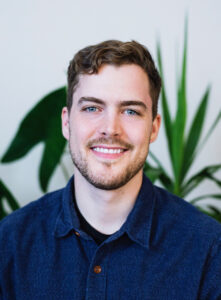Want to simulate airflow around an airplane? Mathematician Brendan Keith can walk you through it. You’d start off with a physical model.
Because there are infinite possible airflow states, “we try to chop the space into cells, which is also called meshing, or find a discrete representation of it – something we can put into a computer,” says Keith, a Brown University applied mathematics assistant professor.
Keith, in his first year of a five-year Department of Energy Early Career Award, works on finite element methods, a workhorse for simulating physical phenomena. He aims to find new ways to improve the old methods scientists rely on to simulate black holes, biological processes like cancer growth and a wide range of other real-world puzzles.
In the air-flow example, meshing allows Keith to turn the space around an airplane into little blocks with a finite number of states while keeping the original airplane geometry intact. Inside each block, a little parcel of simulated fluid moves and interacts with its neighbors.
“Finite element methods were developed decades ago by civil engineers to design large bridges and other types of massive structures,” Keith says. “They were originally used to simulate the stresses within the structures themselves. Applying finite elements to fluid flow came decades later. As an applied mathematician, I study these types of methods using techniques from optimization theory and probability theory with the overall goal of making them better, faster and more accurate. It’s what I’m trying to do with this award: make different types of numerical methods better with a new mathematical technique called entropy regularization.”
The method adds physical constraints to finite element solutions to boost their accuracy. He’s named his technique REASON-3D (randomized, entropic, adaptive and scalable optimization for nonintrusive data-driven design). Keith plans to apply REASON-3D to help improve the DOE’s core computational infrastructure.
“My vision for entropy regularization is huge, which is why I need five years to study it,” he says. “I believe we can apply entropy regularization all over the place.”
‘Each time a new tool comes out, we try to go through all of the old open problems and failures to see if maybe this new idea will help us to make a breakthrough.’
To get there, Keith is developing a class of mesh-independent finite element methods for large-scale physics simulations, meaning that “the algorithm doesn’t need to perform more iterations as the mesh is refined,” he says. “This is a really important property, and there are many engineering problems that don’t yet have mesh-independent solvers.” A solver iterates on a solution so that the physical constraints persist after meshing.
Keith’s techniques also may prove useful in optimizing long-term averages for so-called chaotic fluid-flow problems like wind movements over the ocean and other surfaces. “Say you’re trying to design a wind farm,” Keith explains. “You want to find the best configuration for the wind turbine or the best design for the turbine blades, so you select it and make a decision about how to design this wind farm to collect the most energy, for months or even years. You’re trying to optimize for a very long-term outcome. And, it turns out, it’s really difficult to optimize for these long-term averages.”
Keith believes that REASON-3D also can help ramp up efficiency in energy storage and production while addressing seemingly unrelated “problems that people have been struggling with for decades. We’re mathematicians, and each time a new tool comes out, we try to go through all of the old open problems and failures to see if maybe this new idea will help us to make a breakthrough.”
Although Keith’s work has just begun, he’s already seeing successes in benchmark problems over currently dominant algorithms. But the true testing ground, he says, will come in a few years when his group sets up large-scale tests. “It’s one thing to be outperforming the state-of-the-art algorithms on small problems,” he says, “but quite another thing to be able to scale it up and do something the state-of-the-art can’t do at all.”
Keith’s REASON-3D algorithms are ultimately designed to run massive simulations on ultrafast exascale computers, which perform a billion billion computations per second, or even post-exascale machines, he notes. “We’re now entering a post-exascale age where any modern algorithm must be fast, accurate, robust, reliable and scalable.”
For the past three years, Keith has worked on a large team developing a DOE software library called MFEM, for modular finite element method. It’s what his group will use to help run their big simulations on exascale computers.
He’s also planning to use the Sandia National Laboratories-developed rapid optimization library (ROL) and is working with developers there to put REASON 3-D algorithms into ROL, which is applied throughout Sandia to large-scale optimization and design problems.
“We’re pretty confident,” Keith says. “We’d hoped to come up with new mesh-independent finite element methods and are currently pursuing a rigorous mathematical proof that we really do have one and have started putting implementations into different DOE software and using it there.”
Keith is quick to point out that REASON-3D isn’t purely coding. There’s plenty of intriguing mathematics involved.
“If any young people out there see this and are interested in mathematics, we have very compelling and challenging questions that we need bright new minds to help us work on. And we can even implement things on a computer and see simulations, which I think is a beautiful reward after going through all of the hard work.”

